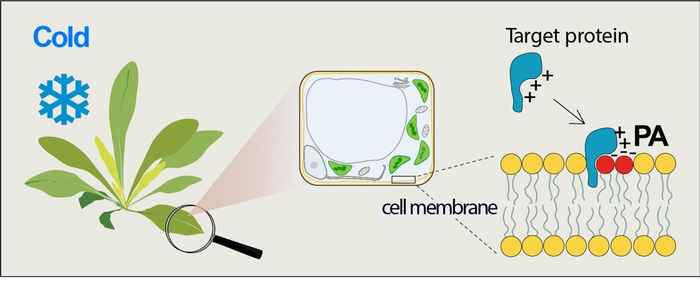NWO-ENW grant for UvA plant biologists to identify protein targets in cold stress signalling
4 November 2020
The researchers have received a grant of €356K for their project ‘Release & Catch! Using a light-controlled probe to uncover the signalling interactome of phosphatidic acid in the plant cold response’, to appoint a PhD candidate for four years. Their primary goal will be to develop an innovative method to identify protein interactors of a lipid called phosphatidic acid (PA) and use this to better understand the plant's response to cold stress. The multidisciplinary research effort will be performed in close collaboration with Prof. Jan van Maarseveen (Bio-inspired Organic Synthesis, HIMS-UvA), Prof. Dorus Gadella and Dr Joachim Goedhart (Molecular Cytology, SILS-UvA), Dr Gertjan Kramer (Mass Spectrometry of Biomolecules, SILS-UvA), and Dr Toon de Kroon (Membrane Biochemistry & Biophysics, Utrecht University).

Finding the interactions of phosphatidic acid
Phosphatidic acid is a highly conserved lipid that is involved in cellular signalling in all eukaryotes. In plants, it is rapidly formed in response to various environmental cues, including cold stress (Fig. 1). When plants experience stressful cold, PA accumulates in cell membranes. Specific target proteins in the cell bind it and thus become transiently anchored to the membrane where they get activated. While these lipid-protein interactions are crucial for plant survival, a reliable method to systematically search for protein binding partners is still lacking. With this prestigious Open Competition NWO-ENW KLEIN grant, a PhD candidate will be appointed to systematically unravel the signalling interactome of PA during cold stress. The PhD candidate will develop and apply a novel ‘Release and Catch’ procedure. Steven Arisz designed this procedure, based on a synthetic light-controllable PA probe, to capture fast and short-lived lipid-protein interactions in living plant cells.
By finding and analysing the interactions that PA makes upon cold stress, the researchers aim to understand the plant's response to cold and freezing temperatures, and to enable targeted breeding for crop resilience. Moreover, the innovative crosslinking technique is likely to find broader applications, extending to other stresses and lipids, for example also in mammalian systems.